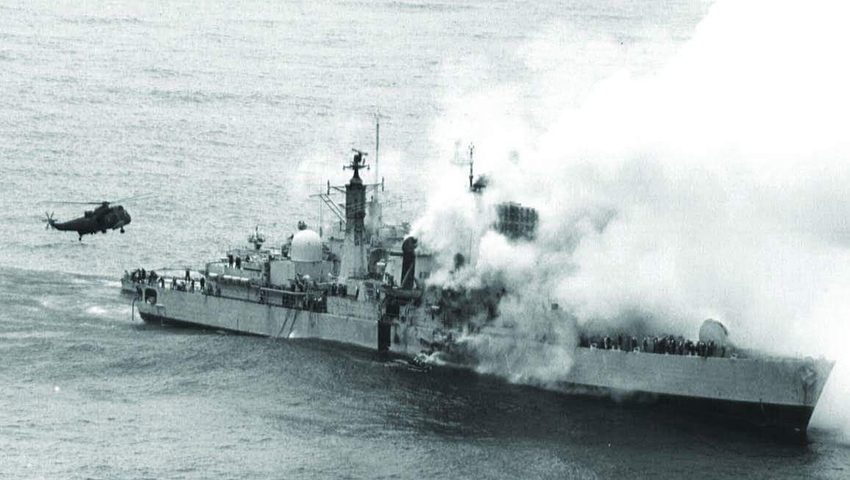History Guild General History Quiz 114
See how your history knowledge stacks up!
Want to know more about any of the questions? Once you’ve finished the quiz click here to learn more.
Have an idea for a question? Suggest it here and we’ll include it in a future quiz!
The stories behind the questions
1. How many large ships were sunk during the Falklands War?
12 – The British lost six: container ship Atlantic Conveyor, landing ship RFA Sir Galahad, frigates HMS Ardent and HMS Antelope and destroyers HMS Coventry and HMS Sheffield. The Argentinians also lost six: cruiser ARA General Belgrano, submarine ARA Santa Fe and four cargo ships.
2. How many Victoria Crosses were awarded for bravery on the first day of Operation Overlord, the Allied invasion of Normandy?
1 – Stanley Hollis, a 31 year old with the Green Howards was awarded the VC for his actions on the 6th of June. His citation is as follows;
in Normandy on 6 June 1944 Company Sergeant-Major Hollis went with his company commander to investigate two German pill-boxes which had been by-passed as the company moved inland from the beaches. “Hollis instantly rushed straight at the pillbox, firing his Sten gun into the first pill-box, He jumped on top of the pillbox, re-charged his magazine, threw a grenade in through the door and fired his Sten gun into it, killing two Germans and taking the remainder prisoners.
Later the same day… C.S.M. Hollis pushed right forward to engage the [field] gun with a PIAT [anti-tank weapon] from a house at 50 yards range… He later found that two of his men had stayed behind in the house…In full view of the enemy who were continually firing at him, he went forward alone…distract their attention from the other men. Under cover of his diversion, the two men were able to get back.
Wherever the fighting was heaviest…[he]…appeared, displaying the utmost gallantry… It was largely through his heroism and resource that the Company’s objectives were gained and casualties were not heavier. ….he saved the lives of many of his men.
3. Which Chancellor oversaw the reunification of Germany?
Helmut Kohl – Kohl was the Chancellor of Germany from 1982 to 1998. He acted decisively following the Revolutions of 1989, bringing about German reunification in 1990. Kohl was also an architect of the Maastricht Treaty which established the EU and the Euro currency.
4. What proportion of Napoleon’s Grand Army that invaded Russia was French?
40% – The Grand army was drawn from across French dominated Europe. Large numbers of German, Austrian, Dutch, Polish, Italian, Swiss, Spanish and Danish soldiers were involved, as well as smaller numbers from many other countries.
5. Which ruling body was dismissed with the phrase ‘In the name of God, go!’?
The English Rump Parliament of 1653 – Spoken by Oliver Cromwell, who believed the Parliament were legislating to ensure their own survival rather than to serve the will of the people. These words were reprised to criticise Neville Chamberlain in 1940 and Boris Johnson in 2022.
6. David Koresh was the leader of which group?
The Branch Davidians – An apocalyptic splinter of the Seventh-day Adventist’s, the Branch Davidians established the Mount Carmel centre near Waco, Texas. David Koresh became the leader of this group in 1984. In 1993 the Bureau of Alcohol, Tobacco, and Firearms attempted to execute a search warrant relating to alleged sexual abuse charges and illegal weapons violations. This was resisted by the Branch Davidians and in the ensuing gun battle 4 ATF agents and 5 Branch Davidians were killed. After a 51 day siege the FBI entered the compound with armoured vehicles, using tear gas in an attempt to flush out the Branch Davidians. During this three fires broke out simultaneously in different parts of the building. The government maintains that the fires were deliberately started by Branch Davidians, while some Branch Davidian survivors maintain that the fires were started either accidentally or deliberately by the assault. Of the 85 Branch Davidians in the compound when the assault began, 76 died, including many by gunshot from fellow Branch Davidians.
7. The battle of Gate Pa was part of which conflict?
The New Zealand Wars – British forces suffered a humiliating defeat in the Battle of Gate Pā on 29 April 1864, with 31 killed and 80 wounded despite outnumbering their Māori foe. This battle was part of the Tauranga campaign in New Zealand’s Bay of Plenty, part of the New Zealand Wars that were fought when European colonists were attempting to take ownership and sovereignty over land owned and occupied by the Māori.
8. The Duchy of Courland existed from 1561 to 1795. Which area did it occupy?
The Baltic Coast – A small principality owing allegiance to the Polish–Lithuanian Commonwealth, the Duchy of Courland was surprisingly active in exploration, colonisation and trade. In 1651-2 the Duchy established colonies in Africa and the Caribbean, at St. Andrews Island on the Gambia River and in Tobago in the West Indies. They exported goods ivory, sugar, tobacco, coffee and spices. They were also active in the slave trade.
9. When was the Australian Labour Party formed?
1891 – The 1891 shearers’ strike lead to the formation of the Australian Labor Party, with their first meeting under a ghost gum tree known as the tree of knowledge in Barcaldine, QLD.
10. What was the former name of Kinshasha, the capital of the Democratic Republic of the Congo?
Leopoldville – Established as a trading post by Henry Stanley in 1881, it was named Leopoldville after King Leopold II of the Belgians, who controlled the Congo Free State, the vast territory that is now the Democratic Republic of the Congo. He owned this not as a colony but as a private property.
Kinshasa faces Brazzaville, the capital of the neighbouring Republic of the Congo. The two cities are the world’s closest pair of capital cities, other than Vatican City and Rome.





